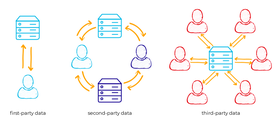How to Build an Omnichannel Marketing Strategy
You’re going to want to add “omnichannel marketing strategy” to your day-to-day dictionary — trust us, it’ll be the only way we sell in the years to come.
Read More
As the phasing out of third-party cookies looms, you’ve probably experienced industry leaders and publications preach about the significance of ramping up your first-party data. After all, what’s not to like about continuing to deliver relevant marketing messages without having to track shoppers’ behaviors online?
It’s clear: As we shift away from third-party data and toward more privacy-driven approaches, investing in a first-party data strategy is imperative for any brand’s success. What exactly does building a first-party data strategy entail? More importantly, how can you get started?
Building a first-party data strategy involves designing a plan to support the collection and application of first-party data — in other words, the information you receive consent for and collect directly from customers via your owned channels.
First-party data is unique to your brand.
With a first-party data strategy, you can:
Future-proof your marketing efforts in the face of third-party cookie changes
Build direct relationships with your customers and better retain existing customers, unlocking higher customer lifetime values
Boost your business ROI — one study found that using first-party data for core marketing functions can give increase revenue by up to 2.9x
Create unique, relevant, and personalized customer experiences that better deliver values
Do you have a firm grasp of your overall business and marketing goals? That’s great! The next step is to identify which ones require first-party data — from there, you can design a comprehensive plan with measurable goals that list out what data to invest in, as well as how you’ll collect, analyze, and use it.
Here are some ideas on ways to use your first-party data:
Create an omnichannel marketing strategy
Retarget browse or cart abandoners
Better understand shoppers and their customer journeys
Drive loyalty and boost retention with existing customers
The key to any successful first-party data strategy is having the right data. With the answers to step one in mind, ask yourself:
What are my current data sources?
What new data points do I need for my goals?
How can I unlock first-party data points that I don’t currently have access to today?
Luckily, there are plenty of channels for obtaining first-party data, including your website, mobile app, CRM, loyalty program, email marketing channel, and call center.
Pro Tip: With shoppers increasingly wary about their data, keep consent management and strong data governance in mind as you brainstorm new ways to collect first-party data. If your brand can show that you treat their data responsibly and respectfully, shoppers will be more willing to share their information with you.
Next up? Determining how you’re putting your collected first-party data in action.
Insights are only as good as how you use them, so we’ve got a few suggestions for you as you tackle the challenge of figuring out how to use your first-party data to improve your customer experiences.
Suggestion 1: Use your first-party data to decide who qualifies for particular customer segments, such as VIPs or loyal customers.
Suggestion 2: Analyze your first-party data to uncover a clearer picture of how shoppers interact with your brand, then use that as a starting point for designing more personalized experiences across your emails, website, and ads.
Here's the part you can't forget: make your value clear. Ensure that the payoff they get for sharing the info with you is clear and on par with the value they give to you.
Building a robust first-party data strategy is not a set-and-done task. Instead, it’s an ongoing process that involves defining targets, tracking your results, and optimizing as you go along.
Before you begin implementing your first-party data strategy, you must determine how you’ll measure the success of not just the various channels where you apply your data, but your overall data strategy. Learn more about key metrics for measuring digital marketing success here.
Despite its obvious perks, many brands have yet to harness the power of first-party data — getting the right people, tools, and processes in place is not as easy as it sounds. The good news? AdRoll can help.
We’ll even provide you with recommendations on next steps.
AdRoll makes it easy to onboard your first-party CRM data — from there, you can design more personalized customer outreach, develop more powerful cart abandonment campaigns, enhance your retargeting efforts, and track how all your marketing efforts are doing in relation to one another via your Cross-Channel Performance Dashboard.
With that, you can say hello to closer relationships with customers, better conversion rates, and higher customer lifetime values. Get started now.
Last updated on August 15th, 2022.

